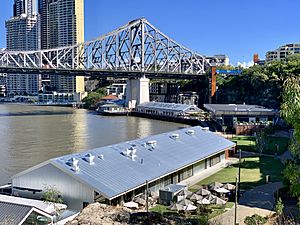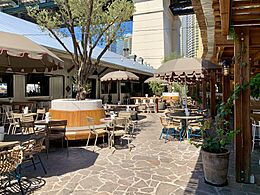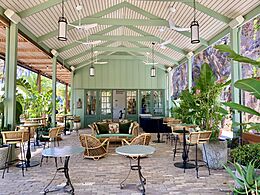Howard Smith Wharves facts for kids
Quick facts for kids Howard Smith Wharves |
|
|---|---|

Howard Smith Wharves, 2019
|
|
| Location | Boundary Street, Brisbane City and Fortitude Valley, City of Brisbane, Queensland, Australia |
| Design period | 1919–1930s (interwar period) |
| Built | c. 1934–1940s circa |
| Official name: Howard Smith Wharves, Brisbane Central Wharves | |
| Type | state heritage (landscape, built) |
| Designated | 4 February 1997 |
| Reference no. | 601781 |
| Significant period | c. 1935–1960s (historical) 1930s–1940s (fabric) |
| Significant components | wharf/dock/quay, views to, bridge/viaduct – road, natural feature – cliff, pylon/s, air raid shelter, pile/s, shed – storage, views from, docking/loading facility, office/administration building |
| Lua error in Module:Location_map at line 420: attempt to index field 'wikibase' (a nil value). | |
|
Howard Smith Wharves
|
||||||||||||||||
|---|---|---|---|---|---|---|---|---|---|---|---|---|---|---|---|---|
| Location | Fortitude Valley Australia |
|||||||||||||||
| Owned by | Brisbane City Council | |||||||||||||||
| Operated by | RiverCity Ferries | |||||||||||||||
| Platforms | 1 | |||||||||||||||
| Other information | ||||||||||||||||
| Fare zone | go card 1 | |||||||||||||||
| History | ||||||||||||||||
| Opened | 2020 | |||||||||||||||
| Services | ||||||||||||||||
|
||||||||||||||||
The Howard Smith Wharves is a special place in Brisbane, Australia. It's a historic wharf area located along the Brisbane River, right under the famous Story Bridge. This site is very important for its history and culture. It was built between 1939 and 1942 and was once known as the Brisbane Central Wharves.
In 2009, the Brisbane City Council wanted to build a big shopping and entertainment area here. But people in the community didn't like the idea. They wanted more public space. So, the plans were changed to include more parks and less building. However, the Queensland Government stopped these new plans because of worries about floods.
Later, in 2013, the Council asked for new ideas to develop the site. A new plan was approved in 2015. The redeveloped Howard Smith Wharves finally opened in late 2018. It became a popular spot for everyone to enjoy. A new ferry stop also opened here in 2020, making it easy to visit by boat.
Contents
History of Howard Smith Wharves
Building the Wharves
The Howard Smith Wharves were built a long time ago, from 1939 to 1942. The Queensland Government started this project to help people find jobs during a tough time called the Great Depression. It was part of a bigger plan that also included building the Story Bridge. These projects not only gave people work but also created important facilities for Queensland's future.
Howard Smith Company's Role
The wharves were first called the Brisbane Central Wharves. A shipping company named Howard Smith Co. Ltd leased them from the mid-1930s to the early 1960s. That's why they are now known as the Howard Smith Wharves. This company had been using wharves in this area since the early 1900s.
Brisbane's Changing Port
Over time, Brisbane's main port activities moved further down the river. In the early days, many wharves were in the central city area. But as ships got bigger, they needed deeper water and more space. After the Story Bridge opened in 1940, many large ships stopped using the central city wharves. By the 1960s, most of Brisbane's port business had moved to the river's mouth.
Second World War and Air-Raid Shelters
During the Second World War, there was a fear of attacks. So, in 1941–42, five air-raid shelters were built near the wharves. These shelters were for the many workers there and to protect people near the important Story Bridge. Some shelters were typical concrete "pillbox" style. Others were made from large concrete pipes, which is quite rare for Brisbane.
After the War
After the Howard Smith Company's lease ended in the 1960s, the Water Police used part of the site. The Queensland Works Department also used it for storage. For many years, the site was mostly empty. In 1974, big floods washed away parts of the timber wharves. Today, the Howard Smith Wharves are one of the few remaining old wharf areas in the central city. They still have their original office building, sheds, and parts of the wharves.
Redevelopment of the Wharves
Early Plans and Community Concerns
In 2009, the Brisbane City Council suggested a big plan to redevelop the wharves. The idea was to have a hotel, restaurants, shops, and entertainment areas. They also planned to keep 80% of the area as public space. However, many people in the community were worried. They thought the new buildings would be too big and would block views. They also wanted to protect the historical look of the area.
Changes to the Plans
Because of the community's concerns, the Council changed its plans. They made the buildings smaller and added a new boardwalk along the river. They also considered a new ferry stop. These revised plans were shared with the public for feedback.
Floods and New Beginnings
After the big floods in Queensland in 2010–2011, the site was underwater. The Queensland Government then rejected the revised plans, saying they were too risky for floods. However, work continued to fix the boardwalks. By 2013, new plans were announced.
The Modern Howard Smith Wharves
In 2014, a new developer was chosen, and their design was approved in 2015. The new Howard Smith Wharves opened in late 2018. It has become a lively place with restaurants, bars, and open spaces for everyone to enjoy. A new ferry terminal opened in 2020, making it even easier for people to visit by CityHopper ferry services.
What You Can See at Howard Smith Wharves
The Howard Smith Wharves are located on the northern side of the Brisbane River. High cliffs form a natural wall behind the site. The Story Bridge also crosses over part of the area.
Buildings and Wharves
You can still see several old buildings at the wharves.
- Water Police Office: This two-story concrete building used to be the main office for the Howard Smith Company. Today, the Water Police use it. It has great views of the river.
- Sheds: There are several large timber-framed sheds (numbered 2, 3, 4, and 5). These sheds have corrugated steel walls and roofs. They were used to store cargo coming off the ships. Shed No. 4 is the biggest, with a double roof.
- Wharf Sections: You can see parts of the old timber wharves that stretch out over the river. These are made of strong hardwood timbers. Some sections have stairs down for smaller boats.
Air-Raid Shelters
Along the base of the cliffs, you can find four old air-raid shelters.
- Pipe Shelters: Two of these shelters are made from large concrete pipes. They have entrances at both ends. These are quite unique!
- Concrete Shelters: The other two shelters are rectangular concrete structures. They were built to protect people during the Second World War.
Cliffs and Surroundings
The tall cliffs behind the wharves are a dramatic sight. They are covered with plants in some places and show exposed rock in others. These cliffs also help support the northern end of the Story Bridge.
Why Howard Smith Wharves is a Heritage Site
The Howard Smith Wharves were added to the Queensland Heritage Register in 1997. This means it's a very important place that needs to be protected.
A Glimpse into Brisbane's Past
The wharves show us how Brisbane's port used to look and work before the 1940s. It's one of the last remaining examples of a central city wharf. It also reminds us of the big projects the government did in the 1930s to create jobs during the Depression.
Unique Air-Raid Shelters
The air-raid shelters here are very special. They are the most complete group of shelters left in Brisbane. The "pipe" shelters are especially rare. They show how people prepared for war and how important the wharves and Story Bridge were at that time.
A Beautiful Landmark
The wharves, with their old buildings and the cliffs, create a beautiful view of the Brisbane River. It's a well-known landmark that adds a lot to the city's look. The old timber wharves have a weathered look that tells stories of their busy past.
Connection to Howard Smith Company
The site is also important because of its long connection to the Howard Smith Co. Ltd. This company was one of Australia's main shipping companies for over 60 years.
See also





